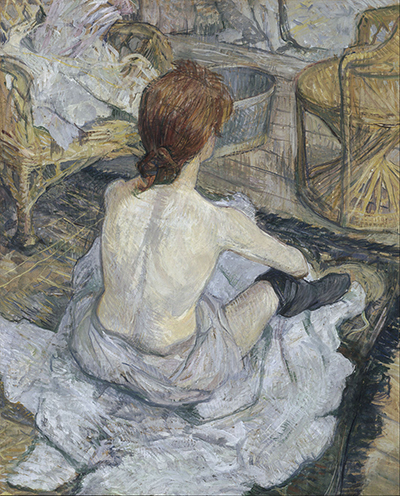Henri de Toulouse-Lautrec painted the La Toilette portrait in 1889. The painting is an oil on cardboard portrait that uses a light colour palette with the most dominant ones being the yellowish greens and the red for the woman's hair.
The image is a nude red-haired woman seated on the floor. The woman is seen from the back and is stripped to the waist, revealing her bare back, arms and legs. There are wicker chairs and a bucket in front of the woman, suggesting that the scene could be at the artist's studio in Caulaincourt. The painting has a sketchy look and portrays a huge similarity to bathing paintings by Degas.
The works of Degas inspire the La Toilette Painting by Henri de Toulouse. A collection of Toulouse-Lautrec's interest in "women bathing" triggered pastels that Degas displayed in the Impressionist exhibition of 1886. Toulouse was a fan of Degas, and he adopted his style as well as his subject-matter in his work. Toulouse would latter meet Degas in 1889 with the help of their mutual friend Desire Dihau. The artist favourite red-redheaded model, Carmen Gaudin, is proposed to have sat for the La Toilette painting. Lack of preliminary drawings for the work suggests that the painting's composition is directly from life.
There have been different views in regards to when the artwork was painted. The artwork was earlier dated 1886, but recent research shows that it was painted in 1889. Toulouse exhibited this artwork in Brussels in 1890, and the title he choose was Rousse meaning red-head. The other misunderstanding is on whether the woman in the painting is a prostitute or not. The wooden floorboards and the furniture already prove that the scene is not in a brothel, but some clothes and the way the woman poses suggest otherwise. The fact that the woman is sited on a sheet with a part of it loosely wrapped around her waist and has a black stocking on her lower leg may suggest that she may be a prostitute.
Though Degas's art influenced Henri de Toulouse's art, he differed from Degas in the way he observed and painted women. Toulouse was known as having a humanistic and realistic view towards women and used art to reflect their circumstances, especially those from marginalised groups such as sex workers that he met at the dance hall. His artwork is also influenced by Japanese print that uses geometric shapes and flat colour areas to show the subjects. Toulouse's artwork was also modern as it had the dazzling effect enabled by the innovations of the late nineteenth century, which made it possible to make larger prints.




